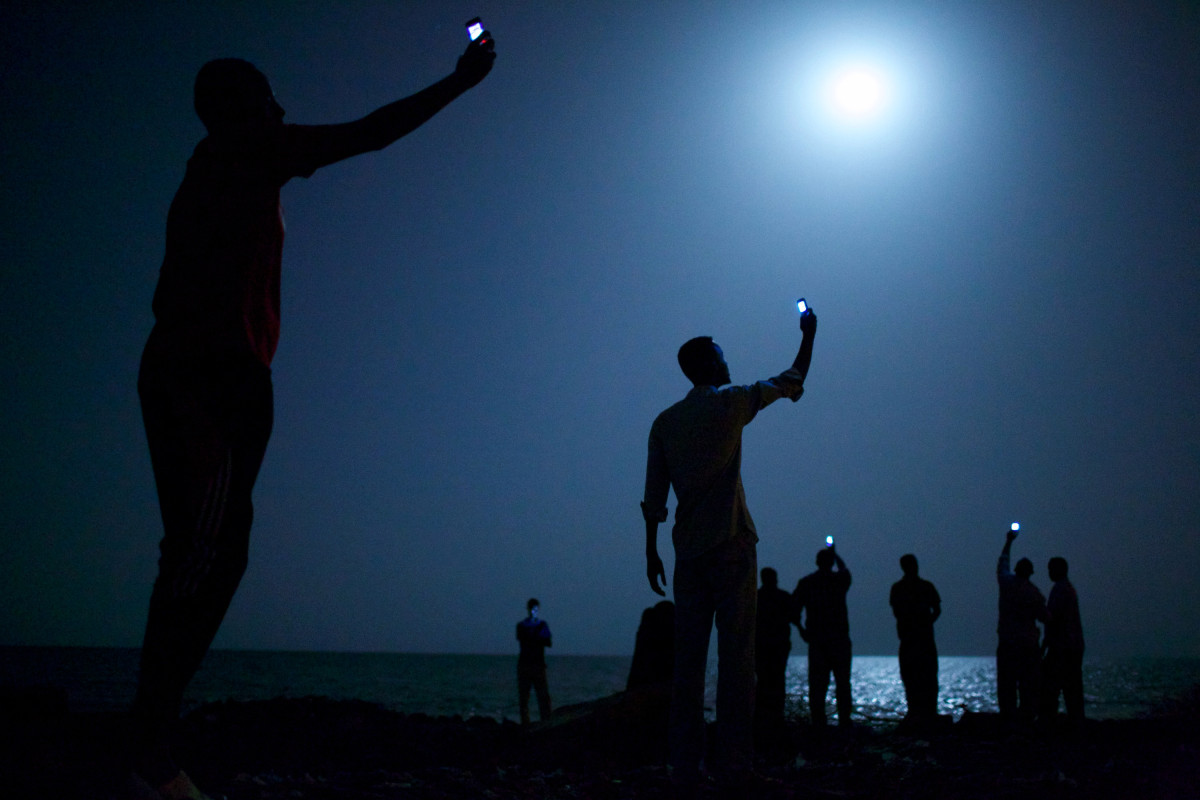
“Through photographs, the world becomes a series of unrelated, free-standing particles; and history, past and present, a set of anecdotes and faits divers,” Susan Sontag wrote in 1977. “The camera makes reality atomic, manageable, and opaque. It is a view of the world which denies interconnectedness, continuity, but which confers on each moment the character of a mystery.”
Sontag’s response to photography almost forty years ago was similar to my own response to this year’s serenely ambiguous World Press Photo winner—except here the photograph is, in effect, apparently about a desire by a cluster of silhouetted men under a moonlit sky to connect: “African migrants on the shore of Djibouti city at night, raising their phones in an attempt to capture an inexpensive signal from neighboring Somalia — a tenuous link to relatives abroad.”
In an increasingly fragmented world where the photojournalistic enterprise has lost much of its communal character—professional photographers have fewer venues which will support them to do this kind of work, readers are refusing to pay to see their imagery (if they can even find the work among the billions of photographs so rapidly posting online), and advertisers are refusing to support the publications that might have funded their work—the single photograph chosen to represent 2013, an extraordinarily turbulent and painful year, is a quiet, abstracted, ceremonial and quasi-religious image that references the difficulties of communication, difficulties shared by today’s photojournalistic community.
Rather than single out a photograph that might have had an impact on public opinion, on governments, on the course of events last year—the often lonely and dangerous task of the photojournalist as social conscience—a symbolic image was chosen representing the problems and necessity of communication over a long distance. And the medium represented in this prize-winning photograph—the cellphone—is not incidentally the primary tool of user-generated social media (for text, video and photography) that bypass traditional media outlets. In the photograph’s depiction of the raising of four illuminated screens to the night sky one can sense not only the ascendance of the cellphone and all that it represents in society, but also the distress of the more traditional press unsure of its own future.
John Stanmeyer, the photographer who authored the prize-winning image (previously published by National Geographic), recently also undertook another project documenting the deteriorating health conditions among refugees in South Sudan. Stanmeyer first distributed his work on social media, via Twitter, Facebook and Instagram, reaching several hundred thousand viewers without needing to wait for a traditional publication to present the photographs (although he did piggyback on several networks, including National Geographic’s Instagram feed). This is good news for readers who want to have a more timely, intimate and direct sense of what is going on elsewhere, including situations in which people are in urgent distress.
John Stanmeyer’s work out of South Sudan
The underlying message of this year’s World Press Photo selection can be seen then as a nod to the increasingly pivotal role of social media, while evoking the situation of many millions of others who, although not African migrants, live much of their days in search of a signal and the connectedness it promises—media migrants who have strayed far from the more proximate physical universe they once inhabited. But with its themes of disconnection and the redemptiveness of connection, the photograph is also nostalgic, a grieving not only for community but also for the part that press photographs played as part of the social glue. The jury’s selection, while not revelatory about the specific plight of African migrants in Djibouti, does point to a larger anxiety about connectedness and the fragile situations not only of millions of dislocated individuals far from home, but also the dislocation of the contemporary photojournalist.
Fred Ritchin is a professor at NYU and co-director of the Photography & Human Rights program at the Tisch School of the Arts. His newest book, Bending the Frame: Photojournalism, Documentary, and the Citizen, was published by Aperture in 2013

More Must-Reads from TIME
- Cybersecurity Experts Are Sounding the Alarm on DOGE
- Meet the 2025 Women of the Year
- The Harsh Truth About Disability Inclusion
- Why Do More Young Adults Have Cancer?
- Colman Domingo Leads With Radical Love
- How to Get Better at Doing Things Alone
- Michelle Zauner Stares Down the Darkness
Contact us at letters@time.com